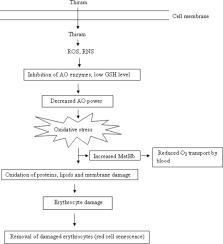当前位置:
X-MOL 学术
›
Pestic. Biochem. Phys.
›
论文详情
Our official English website, www.x-mol.net, welcomes your
feedback! (Note: you will need to create a separate account there.)
Thiram-induced cytotoxicity and oxidative stress in human erythrocytes: An in vitro study
Pesticide Biochemistry and Physiology ( IF 4.2 ) Pub Date : 2020-03-01 , DOI: 10.1016/j.pestbp.2019.12.003 Samreen Salam , Amin Arif , Riaz Mahmood
Pesticide Biochemistry and Physiology ( IF 4.2 ) Pub Date : 2020-03-01 , DOI: 10.1016/j.pestbp.2019.12.003 Samreen Salam , Amin Arif , Riaz Mahmood

|
Tetramethylthiuram disulfide, commonly known as thiram, is an organosulfur compound which is used as a bactericide, fungicide and ectoparasiticide to prevent disease in seeds and crops. Being a fungicide there is a high probability of human occupational exposure to thiram and also via consumption of contaminated food. In this work, the cytotoxicity of thiram was studied under in vitro conditions using human erythrocytes as the cellular model. Erythrocytes were incubated with different concentrations of thiram (25-500 μM) for 4 h at 37 °C. Control cells (thiram untreated) were similarly incubated at 37 °C. Whole cells and hemolysates were analyzed for various biochemical parameters. Treatment of erythrocytes with thiram increased protein and lipid oxidation and hydrogen peroxide level in hemolysates but decreased glutathione and total sulfhydryl group content. This was accompanied by hemoglobin oxidation, heme degradation and release of free iron. Activities of all major antioxidant enzymes were inhibited. The antioxidant power of thiram treated erythrocytes was lowered resulting in decreased metal reducing and free radical quenching ability. These results suggest that thiram enhances the generation of reactive species that cause oxidative modification of cell components. This was confirmed by experiments that showed enhanced generation of reactive oxygen and nitrogen species in thiram treated erythrocytes. Activities of marker enzymes of glucose metabolism and erythrocyte membrane were also inhibited. All effects were seen in a thiram concentration-dependent manner. Electron microscopy further supported the damaging effect of thiram on erythrocytes. Thus thiram induces oxidative stress condition in human erythrocytes and causes oxidative modification of cell components.
中文翻译:

福美双诱导的人红细胞细胞毒性和氧化应激:一项体外研究
四甲基秋兰姆二硫化物,俗称福美双,是一种有机硫化合物,用作杀菌剂、杀真菌剂和外寄生虫剂,以预防种子和作物的病害。作为一种杀菌剂,人类职业性接触福美双的可能性很高,也很可能通过食用受污染的食物。在这项工作中,使用人红细胞作为细胞模型在体外条件下研究了福美双的细胞毒性。红细胞与不同浓度的福美双 (25-500 μM) 在 37°C 下孵育 4 小时。对照细胞(未处理的福美双)类似地在 37°C 下孵育。分析全细胞和溶血产物的各种生化参数。用福美双处理红细胞增加了溶血产物中的蛋白质和脂质氧化以及过氧化氢水平,但降低了谷胱甘肽和总巯基含量。这伴随着血红蛋白氧化、血红素降解和游离铁的释放。所有主要抗氧化酶的活性均受到抑制。福美双处理的红细胞的抗氧化能力降低,导致金属还原和自由基淬灭能力下降。这些结果表明福美双能促进引起细胞成分氧化修饰的活性物质的产生。实验证实了这一点,这些实验表明,福美双处理的红细胞中活性氧和氮物质的产生增强。糖代谢和红细胞膜标记酶的活性也受到抑制。所有效果均以福美双浓度依赖性方式观察到。电子显微镜进一步支持福美双对红细胞的破坏作用。因此福美双在人红细胞中诱导氧化应激状态并引起细胞成分的氧化修饰。
更新日期:2020-03-01
中文翻译:

福美双诱导的人红细胞细胞毒性和氧化应激:一项体外研究
四甲基秋兰姆二硫化物,俗称福美双,是一种有机硫化合物,用作杀菌剂、杀真菌剂和外寄生虫剂,以预防种子和作物的病害。作为一种杀菌剂,人类职业性接触福美双的可能性很高,也很可能通过食用受污染的食物。在这项工作中,使用人红细胞作为细胞模型在体外条件下研究了福美双的细胞毒性。红细胞与不同浓度的福美双 (25-500 μM) 在 37°C 下孵育 4 小时。对照细胞(未处理的福美双)类似地在 37°C 下孵育。分析全细胞和溶血产物的各种生化参数。用福美双处理红细胞增加了溶血产物中的蛋白质和脂质氧化以及过氧化氢水平,但降低了谷胱甘肽和总巯基含量。这伴随着血红蛋白氧化、血红素降解和游离铁的释放。所有主要抗氧化酶的活性均受到抑制。福美双处理的红细胞的抗氧化能力降低,导致金属还原和自由基淬灭能力下降。这些结果表明福美双能促进引起细胞成分氧化修饰的活性物质的产生。实验证实了这一点,这些实验表明,福美双处理的红细胞中活性氧和氮物质的产生增强。糖代谢和红细胞膜标记酶的活性也受到抑制。所有效果均以福美双浓度依赖性方式观察到。电子显微镜进一步支持福美双对红细胞的破坏作用。因此福美双在人红细胞中诱导氧化应激状态并引起细胞成分的氧化修饰。









































 京公网安备 11010802027423号
京公网安备 11010802027423号